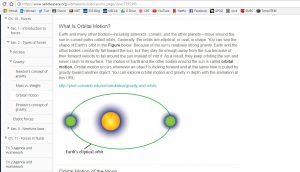Once I got over the hair and trying to identify the decade in which the video was shot, I was pretty captivated by the developmental path of Heather’s concept of an orbit.
Because of the montage style of filming, it is quickly apparent that Heather comes to the class with preconceived, informal notions about the movement of planets. Having taught astronomy, I can attest to there being a ton of information, much of it highly graphical and spread over thousands of years of history and many cultures. In this case, she has superimposed orbital motion with formal learning about the analemma—the relative position of the Sun at noon every day over the course of a year.
I was further struck by the importance of clear graphical representation as illustrated by the “perspective view” of a circular orbit appearing to be an ellipse. At the time of this writing, a Google image search for “orbital motion” delivered this gem:

Hosted proudly on PowerSchool Learning the curriculum clearly shows the Earth in a highly (incorrect) eccentric orbit. For extra irony, there is a link to a PhET animation, arguably the most reliable and accurate simulation space for physics on the web today.
In my exploration of the readings around conceptual challenges I find the “formal versus informal knowledge gap” the most compelling. If formal describes the white-washed, devoid of context topics like “block on an incline” from a standard introduction to physics, then informal is all of the real sensory concepts and language that people develop to explain what they experience in “real life”. Why can’t we spend more time meeting the kids where they are and give them more time to explore? Learn about things that are directly relevant to the structures that they live within? Watching Heather come to an astronomy class and “book learn” about things she cannot touch or clearly observe directly to me is just another example in a career litany of curriculum that is divorced from practical application for the sake of, say, academic purity, or following an “accretion of knowledge” paradigm that is demonstrably not very effective for many learners.
British Columbia is going through an interesting change in curriculum that offers an opportunity to address this formal/informal gap. In broad strokes, the focus has changed from curriculum heavy with “things to be taught” to a reduced list of core competencies and the chances to explore concepts in a way that is deeper and more personally relevant. Although the details and execution are in early days, I believe this is the best chance we’ve had to move the focus of school from teacher-centred to valuing student-centred study. It is my hope that allowing for differentiated instruction and more time to learn, students will have a chance to reduce the formal/informal gap.
Confrey, J. (1990). A Review of the Research on Student Conceptions in Mathematics, Science, and Programming. Review of Research in Education, Vol. 16 pp. 3-56.
Thanks Michael for your explanation of formal vs informal learning. I agree that we need to find a way to meet the students where they are at, and that this could be quite the challenge if we try to stick to teaching students non-concrete concepts, such as the phases of the moon. Even Heather explains in her video that she can’t remember if she was taught where the moon was when she was learning the phases, only that she had to learn the different phases. The concept was not tangible for her, just as certain concepts can be intangible and irrelevant to students. I, too, hope that a marriage can happen between formal and informal learning.
Interesting! Looking at that diagram, it’s no wonder there are so many people who misunderstand the reason for the seasons. Here in Alberta, we are carefully watching what BC is doing with their curriculum redesign. Our Grade 5-6 students have a new CTF (Career and Technology Foundations) requirement starting in September, and the curriculum is very open-ended compared to anything else we have at the moment. There is a little bit of teacher panic as we try to figure out what makes a “good” foundation and interpretations vary widely. Perhaps this is a good thing, though – we will see. I think it is an opportunity to meet kids where they are.